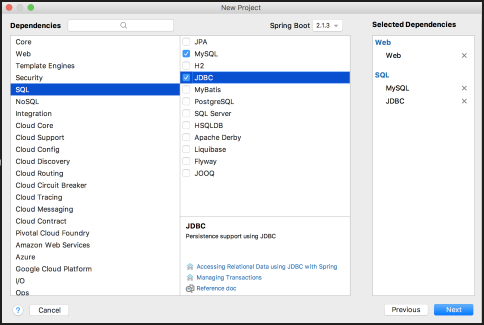您好,登錄后才能下訂單哦!
您好,登錄后才能下訂單哦!
這篇文章主要介紹了Spring JdbcTemplate整合的使用方法是什么,具有一定借鑒價值,需要的朋友可以參考下。希望大家閱讀完這篇文章后大有收獲。下面讓小編帶著大家一起了解一下。
基本配置
JdbcTemplate基本用法實際上很簡單,開發者在創建一個SpringBoot項目時,除了選擇基本的Web依賴,再記得選上Jdbc依賴,以及數據庫驅動依賴即可,如下:

項目創建成功之后,記得添加Druid數據庫連接池依賴(注意這里可以添加專門為Spring Boot打造的druid-spring-boot-starter,而不是我們一般在SSM中添加的Druid),所有添加的依賴如下:
<dependency> <groupId>com.alibaba</groupId> <artifactId>druid-spring-boot-starter</artifactId> <version>1.1.10</version> </dependency> <dependency> <groupId>org.springframework.boot</groupId> <artifactId>spring-boot-starter-jdbc</artifactId> </dependency> <dependency> <groupId>org.springframework.boot</groupId> <artifactId>spring-boot-starter-web</artifactId> </dependency> <dependency> <groupId>mysql</groupId> <artifactId>mysql-connector-java</artifactId> <version>5.1.27</version> <scope>runtime</scope> </dependency>
項目創建完后,接下來只需要在application.properties中提供數據的基本配置即可,如下:
spring.datasource.type=com.alibaba.druid.pool.DruidDataSource
spring.datasource.username=root
spring.datasource.password=123
spring.datasource.url=jdbc:mysql:///test01?useUnicode=true&characterEncoding=UTF-8
如此之后,所有的配置就算完成了,接下來就可以直接使用JdbcTemplate了?咋這么方便呢?其實這就是SpringBoot的自動化配置帶來的好處,我們先說用法,一會來說原理。
基本用法
首先我們來創建一個User Bean,如下:
public class User {
private Long id;
private String username;
private String address;
//省略getter/setter
}然后來創建一個UserService類,在UserService類中注入JdbcTemplate,如下:
@Service
public class UserService {
@Autowired
JdbcTemplate jdbcTemplate;
}好了,如此之后,準備工作就算完成了。
增
JdbcTemplate中,除了查詢有幾個API之外,增刪改統一都使用update來操作,自己來傳入SQL即可。例如添加數據,方法如下:
public int addUser(User user) {
return jdbcTemplate.update("insert into user (username,address) values (?,?);", user.getUsername(), user.getAddress());
}update方法的返回值就是SQL執行受影響的行數。
這里只需要傳入SQL即可,如果你的需求比較復雜,例如在數據插入的過程中希望實現主鍵回填,那么可以使用PreparedStatementCreator,如下:
public int addUser2(User user) {
KeyHolder keyHolder = new GeneratedKeyHolder();
int update = jdbcTemplate.update(new PreparedStatementCreator() {
@Override
public PreparedStatement createPreparedStatement(Connection connection) throws SQLException {
PreparedStatement ps = connection.prepareStatement("insert into user (username,address) values (?,?);", Statement.RETURN_GENERATED_KEYS);
ps.setString(1, user.getUsername());
ps.setString(2, user.getAddress());
return ps;
}
}, keyHolder);
user.setId(keyHolder.getKey().longValue());
System.out.println(user);
return update;
}實際上這里就相當于完全使用了JDBC中的解決方案了,首先在構建PreparedStatement時傳入Statement.RETURN_GENERATED_KEYS,然后傳入KeyHolder,最終從KeyHolder中獲取剛剛插入數據的id保存到user對象的id屬性中去。
你能想到的JDBC的用法,在這里都能實現,Spring提供的JdbcTemplate雖然不如MyBatis,但是比起Jdbc還是要方便很多的。
刪
刪除也是使用update API,傳入你的SQL即可:
public int deleteUserById(Long id) {
return jdbcTemplate.update("delete from user where id=?", id);
}當然你也可以使用PreparedStatementCreator。
改
public int updateUserById(User user) {
return jdbcTemplate.update("update user set username=?,address=? where id=?", user.getUsername(), user.getAddress(),user.getId());
}當然你也可以使用PreparedStatementCreator。
查
查詢的話,稍微有點變化,這里主要向大伙介紹query方法,例如查詢所有用戶:
public List<User> getAllUsers() {
return jdbcTemplate.query("select * from user", new RowMapper<User>() {
@Override
public User mapRow(ResultSet resultSet, int i) throws SQLException {
String username = resultSet.getString("username");
String address = resultSet.getString("address");
long id = resultSet.getLong("id");
User user = new User();
user.setAddress(address);
user.setUsername(username);
user.setId(id);
return user;
}
});
}查詢的時候需要提供一個RowMapper,就是需要自己手動映射,將數據庫中的字段和對象的屬性一一對應起來,這樣。。。。嗯看起來有點麻煩,實際上,如果數據庫中的字段和對象屬性的名字一模一樣的話,有另外一個簡單的方案,如下:
public List<User> getAllUsers2() {
return jdbcTemplate.query("select * from user", new BeanPropertyRowMapper<>(User.class));
}至于查詢時候傳參也是使用占位符,這個和前文的一致,這里不再贅述。
其他
除了這些基本用法之外,JdbcTemplate也支持其他用法,例如調用存儲過程等,這些都比較容易,而且和Jdbc本身都比較相似,這里也就不做介紹了,有興趣可以留言討論。
原理分析
那么在SpringBoot中,配置完數據庫基本信息之后,就有了一個JdbcTemplate了,這個東西是從哪里來的呢?源碼在
org.springframework.boot.autoconfigure.jdbc.JdbcTemplateAutoConfiguration類中,該類源碼如下:
@Configuration
@ConditionalOnClass({ DataSource.class, JdbcTemplate.class })
@ConditionalOnSingleCandidate(DataSource.class)
@AutoConfigureAfter(DataSourceAutoConfiguration.class)
@EnableConfigurationProperties(JdbcProperties.class)
public class JdbcTemplateAutoConfiguration {
@Configuration
static class JdbcTemplateConfiguration {
private final DataSource dataSource;
private final JdbcProperties properties;
JdbcTemplateConfiguration(DataSource dataSource, JdbcProperties properties) {
this.dataSource = dataSource;
this.properties = properties;
}
@Bean
@Primary
@ConditionalOnMissingBean(JdbcOperations.class)
public JdbcTemplate jdbcTemplate() {
JdbcTemplate jdbcTemplate = new JdbcTemplate(this.dataSource);
JdbcProperties.Template template = this.properties.getTemplate();
jdbcTemplate.setFetchSize(template.getFetchSize());
jdbcTemplate.setMaxRows(template.getMaxRows());
if (template.getQueryTimeout() != null) {
jdbcTemplate
.setQueryTimeout((int) template.getQueryTimeout().getSeconds());
}
return jdbcTemplate;
}
}
@Configuration
@Import(JdbcTemplateConfiguration.class)
static class NamedParameterJdbcTemplateConfiguration {
@Bean
@Primary
@ConditionalOnSingleCandidate(JdbcTemplate.class)
@ConditionalOnMissingBean(NamedParameterJdbcOperations.class)
public NamedParameterJdbcTemplate namedParameterJdbcTemplate(
JdbcTemplate jdbcTemplate) {
return new NamedParameterJdbcTemplate(jdbcTemplate);
}
}
}從這個類中,大致可以看出,當當前類路徑下存在DataSource和JdbcTemplate時,該類就會被自動配置,jdbcTemplate方法則表示,如果開發者沒有自己提供一個JdbcOperations的實例的話,系統就自動配置一個JdbcTemplate Bean(JdbcTemplate是JdbcOperations接口的一個實現)。好了,不知道大伙有沒有收獲呢?
感謝你能夠認真閱讀完這篇文章,希望小編分享Spring JdbcTemplate整合的使用方法是什么內容對大家有幫助,同時也希望大家多多支持億速云,關注億速云行業資訊頻道,遇到問題就找億速云,詳細的解決方法等著你來學習!
免責聲明:本站發布的內容(圖片、視頻和文字)以原創、轉載和分享為主,文章觀點不代表本網站立場,如果涉及侵權請聯系站長郵箱:is@yisu.com進行舉報,并提供相關證據,一經查實,將立刻刪除涉嫌侵權內容。